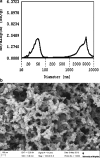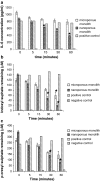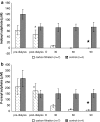An adsorbent monolith device to augment the removal of uraemic toxins during haemodialysis
- PMID: 24573455
- PMCID: PMC4033810
- DOI: 10.1007/s10856-014-5173-9
An adsorbent monolith device to augment the removal of uraemic toxins during haemodialysis
Abstract
Adsorbents designed with porosity which allows the removal of protein bound and high molecular weight uraemic toxins may improve the effectiveness of haemodialysis treatment of chronic kidney disease (CKD). A nanoporous activated carbon monolith prototype designed for direct blood contact was first assessed for its capacity to remove albumin bound marker toxins indoxyl sulphate (IS), p-cresyl sulphate (p-CS) and high molecular weight cytokine interleukin-6 in spiked healthy donor studies. Haemodialysis patient blood samples were then used to measure the presence of these markers in pre- and post-dialysis blood and their removal by adsorbent recirculation of post-dialysis blood samples. Nanopores (20-100 nm) were necessary for marker uraemic toxin removal during in vitro studies. Limited removal of IS and p-CS occurred during haemodialysis, whereas almost complete removal occurred following perfusion through the carbon monoliths suggesting a key role for such adsorbent therapies in CKD patient care.
Figures




Similar articles
-
A haemocompatible and scalable nanoporous adsorbent monolith synthesised using a novel lignin binder route to augment the adsorption of poorly removed uraemic toxins in haemodialysis.Biomed Mater. 2017 May 10;12(3):035001. doi: 10.1088/1748-605X/aa6546. Biomed Mater. 2017. PMID: 28270638
-
Removal of protein-bound uraemic toxins by haemodialysis.Blood Purif. 2013;35 Suppl 2:20-5. doi: 10.1159/000350843. Epub 2013 May 3. Blood Purif. 2013. PMID: 23676831 Review.
-
Removal of protein-bound, hydrophobic uremic toxins by a combined fractionated plasma separation and adsorption technique.Artif Organs. 2013 Apr;37(4):409-16. doi: 10.1111/j.1525-1594.2012.01570.x. Epub 2013 Jan 18. Artif Organs. 2013. PMID: 23330821
-
Protein-bound uraemic toxin removal in haemodialysis and post-dilution haemodiafiltration.Nephrol Dial Transplant. 2010 Jan;25(1):212-8. doi: 10.1093/ndt/gfp437. Epub 2009 Sep 15. Nephrol Dial Transplant. 2010. PMID: 19755476 Clinical Trial.
-
Meta-Analysis of the Associations of p-Cresyl Sulfate (PCS) and Indoxyl Sulfate (IS) with Cardiovascular Events and All-Cause Mortality in Patients with Chronic Renal Failure.PLoS One. 2015 Jul 14;10(7):e0132589. doi: 10.1371/journal.pone.0132589. eCollection 2015. PLoS One. 2015. PMID: 26173073 Free PMC article. Review.
Cited by
-
Portable and wearable dialysis devices for the treatment of patients with end-stage kidney failure: Wishful thinking or just over the horizon?Pediatr Nephrol. 2015 Dec;30(12):2053-60. doi: 10.1007/s00467-014-2968-3. Epub 2014 Oct 21. Pediatr Nephrol. 2015. PMID: 25330876 Free PMC article. Review.
-
p-Cresyl Sulfate.Toxins (Basel). 2017 Jan 29;9(2):52. doi: 10.3390/toxins9020052. Toxins (Basel). 2017. PMID: 28146081 Free PMC article. Review.
-
High performance of a unique mesoporous polystyrene-based adsorbent for blood purification.Regen Biomater. 2017 Feb;4(1):31-37. doi: 10.1093/rb/rbw038. Epub 2016 Dec 24. Regen Biomater. 2017. PMID: 28149527 Free PMC article.
-
New low-flux mixed matrix membranes that offer superior removal of protein-bound toxins from human plasma.Sci Rep. 2016 Oct 5;6:34429. doi: 10.1038/srep34429. Sci Rep. 2016. PMID: 27703258 Free PMC article.
-
Selective Transport of Protein-Bound Uremic Toxins in Erythrocytes.Toxins (Basel). 2019 Jul 1;11(7):385. doi: 10.3390/toxins11070385. Toxins (Basel). 2019. PMID: 31266243 Free PMC article.
References
-
- Locatelli F, Martin-Malo A, Hannedouche T, Loureiro A, Papadomitriou M, Wizemann V, Jacobson S, Czekalski S, Ronco C, Vanholder R, Membrane Permeability Outcome (MPO) Study Group Effect of membrane permeability on survival of haemodialysis patients. J Am Soc Nephrol. 2009;20:645–654. doi: 10.1681/ASN.2008060590. - DOI - PMC - PubMed
-
- Eknoyan G, Beck GJ, Cheung AK, Daugirdas J, Greene T, Kusek JW, Allon M, Delmez JA, Depner TA, Dwyer JT, Levey AS, Levin NW, Milford E, Ornt DB, Rocco MV, Schulman G, Schwab SJ, Teehan BP, Toto R. Effect of dialysis dose and membrane flux in maintenance hemodialysis. N Engl J Med. 2002;347(25):2010–2019. doi: 10.1056/NEJMoa021583. - DOI - PubMed
Publication types
MeSH terms
Substances
Grants and funding
LinkOut - more resources
Full Text Sources
Other Literature Sources
Medical

